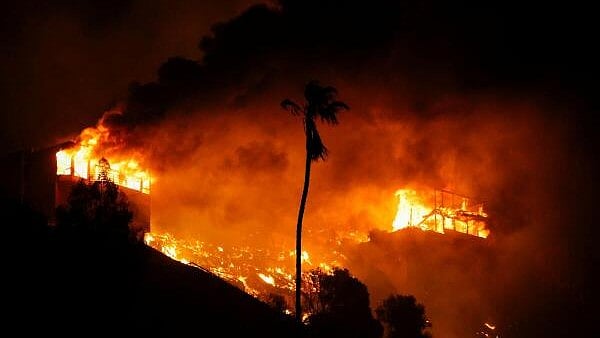
The largest of the blazes, the Palisades fire, had consumed more than 1,000 structures, making it the most destructive in Los Angeles history.
Credit: Reuters Photo
A new wildfire broke out Wednesday evening in the Hollywood Hills, an area of central Los Angeles indelibly associated with the American film industry, as emergency crews struggled against several other devastating blazes that were raging out of control and forcing desperate evacuations.
The new 20-acre blaze, the Sunset fire, was burning near hiking trails and secluded mansions. Officials issued a mandatory evacuation order in a wealthy area bordered by Mulholland Drive and Hollywood Boulevard, street names that evoke the grandeur and romance of the movies. The iconic “Hollywood” sign stands nearby on the other side of the 101 Freeway.
Even though wildfires are a fact of life in Southern California, the experience of watching one encroach upon a metropolitan area left some residents deeply unsettled and afraid.
As of early Wednesday evening, five people had died as a result of the wildfires, more than 25,000 acres had burned, more than 1,00,000 people were under mandatory evacuation orders and hundreds of thousands of customers had lost power. Glowing embers were floating through the sky like lightning bugs as thick black smoke turned day into night.
The largest of the blazes, the Palisades fire, had consumed more than 1,000 structures, making it the most destructive in Los Angeles history, according to Cal Fire, the state fire agency.
More than 12 million people in Southern California were under a red flag warning, the highest fire-related alert issued by the National Weather Service, by 8 pm.
The agency said “extremely critical” fire weather conditions — the result of strong winds and dry conditions — were forecast to wane overnight. But conditions would remain “critically elevated” through at least Thursday and potentially into Friday, it said.
Here’s what else to know:
Other fires: East of Los Angeles in Eaton Canyon, the day-old Eaton fire had reached Pasadena and consumed more than 10,000 acres as of Wednesday afternoon. Another blaze that started on Tuesday, the Hurst fire in the San Fernando Valley, had grown to more than 500 acres.
Water availability: A lack of water has hampered crews’ efforts to beat back the major fires and several smaller ones The Los Angeles Department of Water & Power said that the department had filled reservoirs across the city before the windstorm. But with so many trucks connected to hydrants, and no aerial support possible, the tanks were depleted.
Climate context: Santa Ana winds are notorious for spreading wildfire, and they often occur in colder months. By January, though, their impacts are usually less dramatic, as the landscape is typically less flammable after rains in the fall and early winter. But this year, the rains have not come, leaving most of Southern California extremely dry. Scientists have also found that fires across the region have become faster-moving in recent decades.